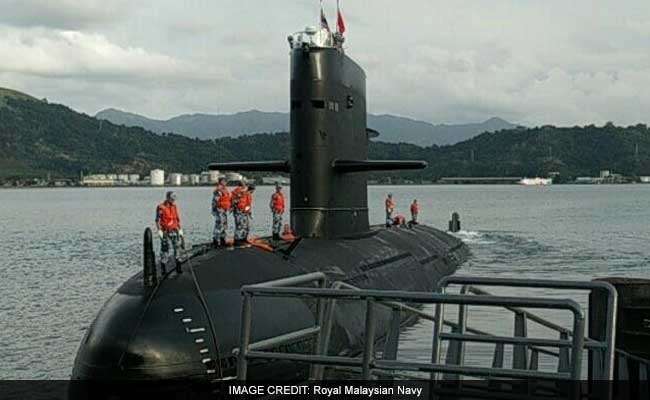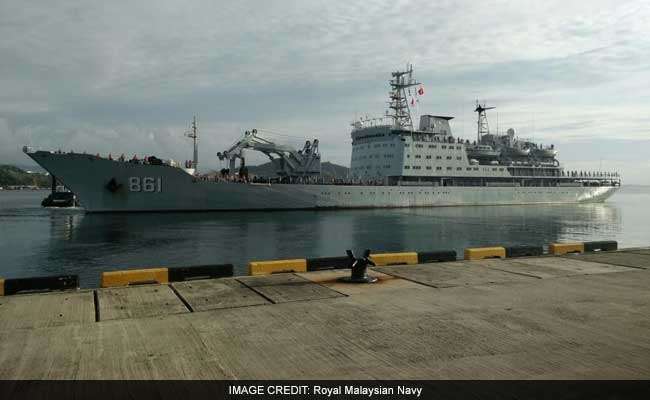January 7, 2017
New Delhi: In yet another sign of Beijing's growing Naval might, a fresh image has emerged of a Chinese diesel-electric submarine in Kota Kinabalu in Malaysia after an extended deployment in the Indian Ocean.

Chinese submarine docked at Kota Kinabalu for rest and recreation for its sailors and to resupply.
January 7, 2017
New Delhi: In yet another sign of Beijing's growing Naval might, a fresh image has emerged of a Chinese diesel-electric submarine in Kota Kinabalu in Malaysia after an extended deployment in the Indian Ocean.

Chinese submarine docked at Kota Kinabalu for rest and recreation for its sailors and to resupply.
In a report yesterday, NDTV showed a Google Earth image of a Chinese nuclear submarine which had docked in Karachi in May last year – a matter of serious concern for the Indian Navy which is worried about Chinese submarines tracking the movements of its own ships and submarines in the Indian Ocean.
Images on the Royal Malaysian Navy's official Twitter page show images of what is thought to be a Type 039 'Song' class diesel electric submarine at Kota Kinabalu along with a large support ship. And in a statement released last night, the Chinese Defence Ministry is reported to have said that the submarine had docked in Malaysia for supplies and a crew rest period while returning from what Beijing insists are anti-piracy patrols off the coast of Somalia.
This is an assertion rejected outright by the Indian Navy which points out that advanced military assets like a submarines are hardly appropriate in tackling Somali pirates who sail the seas off the Horn of Africa in small skiffs. The Chinese submarine has been docked at Kota Kinabalu since Tuesday and was scheduled to depart today.
India presently operates only a single nuclear attack submarine, a Russian designed Akula-2 class boat named INS Chakra. India's indigenous nuclear ballistic missile submarine, the INS Arihant is thought to have recently entered service with the Navy after lengthy trials in the Bay of Bengal.
India has plans to build a number of indigenous nuclear fast attack submarines but these are likely to be at least a decade away from being delivered. In addition to this, India operates 13 Russian and German designed diesel-electric submarines with the first of six new French-designed 'Scorpene' class submarines still to enter service. Meanwhile, China, which has been rapidly expanding its Navy, has between 12 and 15 nuclear submarines of all types which have either been commissioned or are in an advanced stage of construction. In addition to this, China operates 56 conventionally powered submarines, making it the second largest operator of submarines in the world.

China song class submarine support ship
The Chinese 'Song' class submarine was accompanied by a support ship.
Unlike conventional submarines, nuclear-powered submarines have an unlimited range of operations since their nuclear reactors rarely require to be refuelled. This means the submarines, which are armed with torpedoes and cruise missiles, can be deployed underwater for extended durations.
Diesel electric submarines, like the one which docked in Kota Kinabalu are, however, more silent when operating underwater on electric propulsion but need to surface periodically, at which stage they are more vulnerable to detection. In October 2006, in a huge embarrassment to the US Navy, a Chinese Song class submarine reportedly surfaced within nine kilometres of the aircraft carrier USS Kitty Hawk which was operating in the East China Sea. The Chinese submarine had gone undetected and surfaced within the firing range of its torpedoes.
Last month, Navy Chief Admiral Sunil Lanba said, "As far as People's Liberation Army (PLA) Navy ships and submarines are concerned, the Indian Navy keeps a close eye and monitor their movements. We launch surveillance missions in the form of aircraft and ships to keep a track of them."
Courtesy: NDTV
















































































































